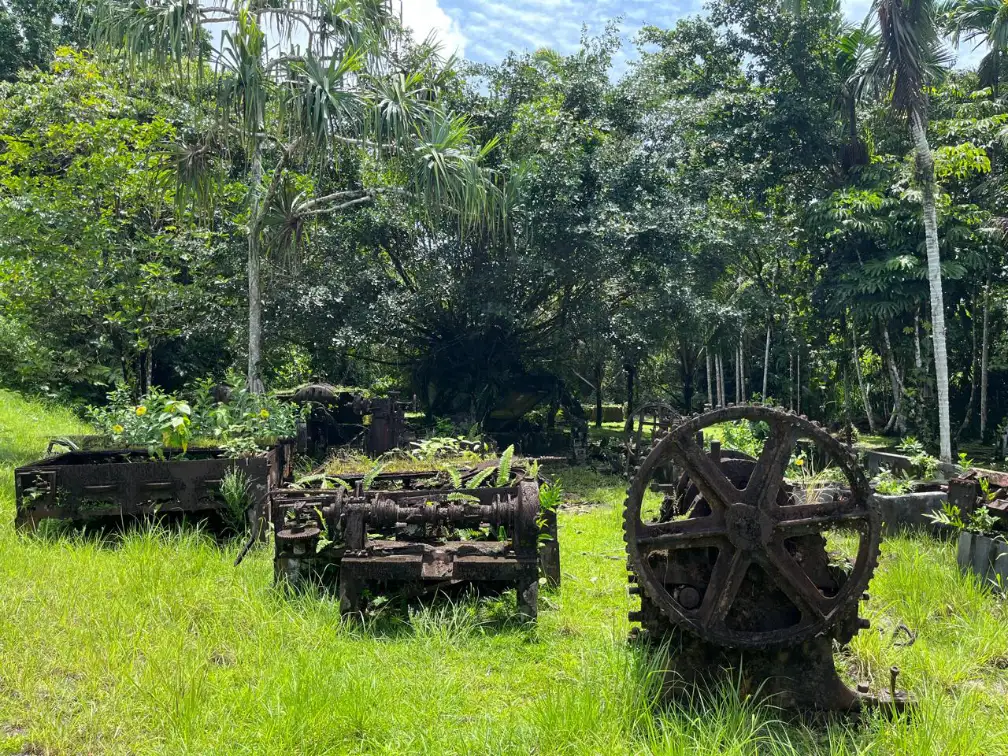The concrete ruins scattered through the jungle in Ngaremlengui don't look like much today - weathered foundations, rusted machinery, vegetation slowly reclaiming what was once a bustling industrial site. But these remnants of a Japanese pineapple canning factory tell one of Palau's most dramatic stories - how 15,000 Japanese settlers once outnumbered 6,000 Palauans in their own homeland.
The Forgotten Pineapple Factory - A Window into Palau's Colonial Past
Table of Contents
When Japan Transformed Palau
After World War I, the League of Nations granted Japan control over Palau and other Pacific islands through the South Seas Mandate in 1920. Unlike other colonial powers focused on resource extraction, Japan envisioned permanent settlement and comprehensive economic development. They wanted profitable, self-sustaining colonies that would contribute to the empire rather than drain it.
The results were extraordinary. By 1938, Japanese residents outnumbered indigenous Palauans 2.5 to 1. Koror had become essentially a Japanese city in the Pacific. The colonial government actively encouraged migration, offering incentives for settlers to establish plantations, businesses, and industrial enterprises like the pineapple factory.
The demographic transformation was unprecedented in Pacific colonial history. Walking through Palau today, it's hard to imagine that indigenous people were once a minority in their own islands.
The Pineapple Factory's Place
The factory operated during the 1930s as part of Japan's strategy to make the mandate territories financially independent. By the late 1920s, they had succeeded - the mandate no longer required subsidies and actually contributed to the imperial treasury. While phosphate mining on Angaur was the main economic driver, agricultural ventures like pineapple cultivation diversified the colonial economy.
Japanese settlers managed the Ngaremlengui operation, bringing industrial canning technology to Palau for the first time. The facility processed pineapples from local plantations, canning them for markets in Japan and throughout the empire. It represented an early example of global food processing in the Pacific.
Rail systems moved products through the facility. For a brief period, this remote Pacific location operated as a sophisticated food processing center.

The Human Cost
For Palauans, economic development came at enormous cultural cost. The colonial government implemented forced assimilation policies, requiring children to speak Japanese in schools and discouraging traditional ceremonies. Traditional governance structures were dismantled and replaced with Japanese administrative systems.
The economic benefits were limited and unevenly distributed. While some Palauans found employment in the pineapple plantations and factory, they occupied the lowest-paid positions. Management, technical roles, and ownership remained in Japanese hands. Profits flowed to Japan or stayed within the settler community.
Forced labor became common. Palauans were conscripted for phosphate mines, construction projects, and agricultural ventures. Military conscription disrupted traditional life as World War II approached. The demographic imbalance meant Palauans often felt like strangers in their own communities.
Sudden Abandonment
The Japanese surrender in 1945 changed everything overnight. Virtually the entire Japanese population - those 15,000 settlers - was repatriated within months. The pineapple factory was simply abandoned, along with dozens of other industrial enterprises.
The entire colonial economic infrastructure collapsed instantaneously. For Palauans, this brought both liberation and uncertainty. They regained demographic dominance but inherited an economy designed for Japanese interests. The industrial knowledge and international connections that made the factory profitable disappeared with the Japanese population.
What the Ruins Reveal
Today's deteriorated machinery and overgrown foundations aren't spectacular, but they're profoundly significant as evidence of this unique historical moment. The ruins demonstrate both the ambitions and ultimate fragility of the colonial project.
These remains remind us that impressive development projects don't automatically benefit local communities. The factory contributed to Palau's modernization but was part of a system that systematically marginalized indigenous people. Industrial progress was built on cultural suppression and economic exploitation.

The Broader Tour Experience
Our land tours combine the pineapple factory with traditional cultural sites and natural landmarks like waterfalls. This combination is intentional. The waterfalls represent continuity - they provided fresh water and spiritual significance to Palauans long before Japanese settlers arrived and continue to do so today. Traditional sites demonstrate how Palauan culture survived colonial suppression.
Experiencing both colonial ruins and enduring Palauan heritage gives visitors a complete picture of how this island nation navigated modernization while maintaining its identity.
Contemporary Relevance
The factory's story raises questions about development, cultural preservation, and local control that remain relevant today. Modern Palau faces similar challenges - balancing economic development with cultural preservation, benefiting from international connections without losing autonomy, managing demographic and environmental pressures.
Interestingly, contemporary Japanese visitors are welcomed warmly. Many Palauans recognize that modern Japanese tourism contributes positively to the economy without the cultural suppression of the colonial period. This pragmatic approach reflects Palauan resilience and adaptability.
Understanding Historical Layers
The pineapple factory ruins help visitors understand Palau's complex development. This isn't a simple story of progress or exploitation - it's a nuanced example of how colonialism simultaneously modernized and devastated Pacific societies.
The seemingly modest ruins become a powerful reminder that no colonial project, however technologically advanced, can permanently suppress indigenous communities. The factory operated for barely a decade, but Palauan culture has endured for millennia and continues to evolve on its own terms. That's the real story these ruins tell - not just about industrial ambition, but about cultural survival and the complex legacy of development in the Pacific.

